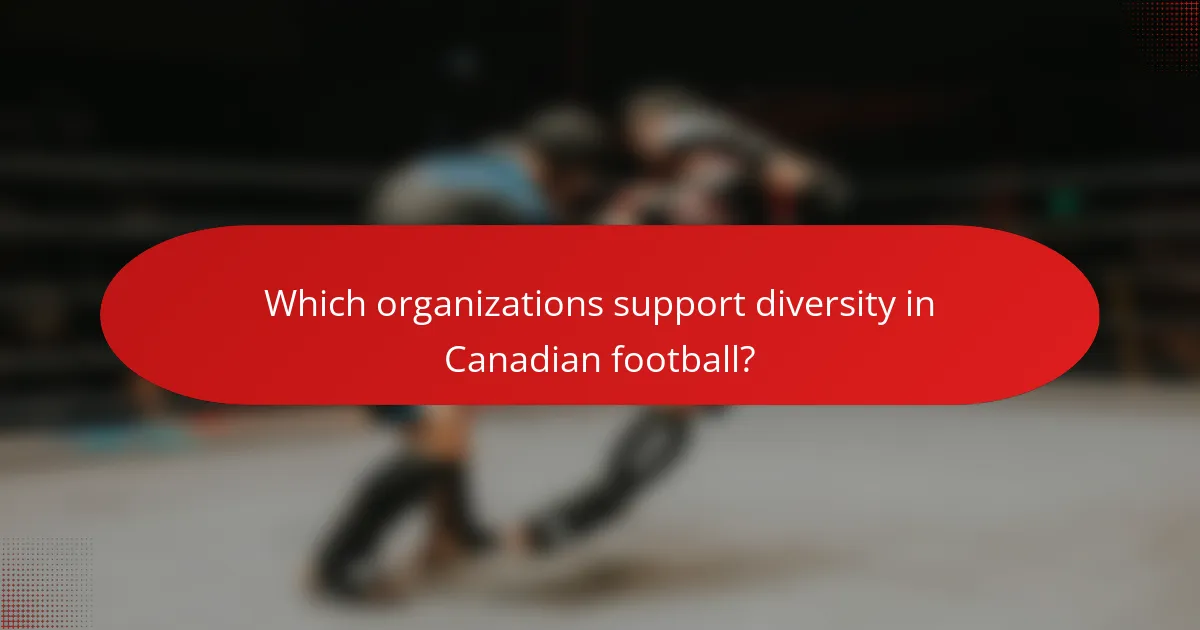Canadian football plays a vital role in promoting inclusion and diversity within communities. It fosters community engagement through outreach programs and encourages representation across various demographics. The sport faces challenges such as accessibility and cultural diversity, yet it strives to create opportunities for underrepresented groups. By showcasing diverse role models and partnering with local organizations, Canadian football enhances social cohesion and strengthens community ties.

How does Canadian football foster community engagement and inclusivity?
Canadian football fosters community engagement and inclusivity by uniting diverse groups through shared experiences. The sport promotes participation across various demographics, encouraging collaboration and teamwork. Local teams often engage in outreach programs, enhancing social bonds and providing opportunities for underrepresented communities. Events like community games and youth clinics emphasize accessibility, creating a welcoming environment for all participants. This focus on inclusivity not only strengthens community ties but also enriches the overall football culture in Canada.
What initiatives promote diversity within Canadian football teams?
Canadian football teams promote diversity through community outreach programs, inclusive hiring practices, and partnerships with minority organizations. These initiatives foster a welcoming environment for players and fans from various backgrounds. For example, the Canadian Football League (CFL) has launched campaigns to celebrate cultural heritage and support local minority communities. By engaging in these activities, teams not only enhance their rosters but also strengthen community ties, reflecting a commitment to inclusion.
Which community programs leverage Canadian football for social change?
Canadian football community programs actively promote inclusion and diversity through various initiatives. Organizations leverage the sport to foster social change, targeting youth engagement and community development.
One prominent example is the CFL’s “Football for All” initiative, which aims to break down barriers and provide opportunities for underrepresented groups. This program emphasizes accessibility and encourages participation from diverse backgrounds.
Additionally, local teams often collaborate with schools and community centres to host football clinics. These events focus on teamwork and respect, instilling values that transcend the sport.
Moreover, initiatives like “Play It Forward” utilize football to support mental health awareness and provide resources for marginalized communities. Through these programs, Canadian football serves as a powerful tool for social transformation.

Why is representation important in Canadian football?
Representation in Canadian football is crucial for fostering inclusion and diversity within communities. It allows individuals from various backgrounds to see themselves in the sport, promoting a sense of belonging. This visibility encourages participation, leading to a more vibrant and diverse community culture. Canadian football programs often engage in outreach initiatives, targeting underrepresented groups and providing opportunities for youth to participate in the sport. As a result, these efforts not only enhance the sport’s popularity but also contribute positively to social cohesion. Representation thus serves as a powerful tool for community development and integration in Canadian football.
How does player diversity impact team performance and community perception?
Player diversity enhances team performance and positively influences community perception. A diverse team brings varied perspectives, fostering creativity and adaptability on the field. This inclusivity resonates with fans, creating a broader support base and stronger community ties. Canadian football promotes these values through initiatives that encourage participation from all backgrounds, reinforcing social cohesion and representation. Such efforts not only improve team dynamics but also elevate the sport’s image as a champion of diversity and inclusion.
What role do coaches and staff play in promoting inclusivity?
Coaches and staff play a crucial role in promoting inclusivity within Canadian football communities. They foster an environment where diversity is celebrated and every participant feels valued.
Through mentorship programs, coaches can support underrepresented groups, ensuring equal opportunities in sports. Staff training focused on inclusivity further enhances team dynamics, creating a welcoming atmosphere.
Moreover, community outreach initiatives led by coaches promote engagement with diverse populations, highlighting the sport’s accessibility. This commitment to inclusivity not only enriches the team culture but also strengthens community ties.
Ultimately, the proactive involvement of coaches and staff is essential in driving positive change, making Canadian football a model for inclusivity in sports.

Which organizations support diversity in Canadian football?
Several organizations support diversity in Canadian football, including the Canadian Football League (CFL), Football Canada, and various community-based initiatives. These entities promote inclusion through programs, outreach efforts, and partnerships aimed at fostering diverse participation in the sport. The CFL has initiatives like the “CFL Diversity and Inclusion Action Plan,” which focuses on creating opportunities for underrepresented groups. Football Canada also emphasizes inclusivity through coaching and player development programs that encourage participation from all communities. Additionally, local clubs often engage in outreach to ensure that football is accessible to diverse populations, enhancing community representation in the sport.
What partnerships exist between Canadian football leagues and local communities?
Canadian football leagues actively partner with local communities to enhance inclusion and diversity. These collaborations include outreach programs, youth initiatives, and community events that promote engagement and support marginalized groups. For instance, leagues often host workshops and training camps aimed at underrepresented populations, fostering a sense of belonging. Additionally, partnerships with local organizations help amplify these efforts, ensuring resources reach those in need. These initiatives not only strengthen community ties but also reflect the leagues’ commitment to social responsibility and cultural sensitivity.
How do sponsorships influence diversity initiatives in Canadian football?
Sponsorships significantly enhance diversity initiatives in Canadian football by providing essential funding and visibility. They facilitate programs that promote inclusion, attracting diverse participants and fostering community engagement. For instance, partnerships with local organizations can lead to outreach efforts that support underrepresented groups in sports. This collaborative approach not only enriches the football community but also aligns with broader societal goals of equity and representation.

What unique challenges does Canadian football face in promoting inclusion?
Canadian football faces unique challenges in promoting inclusion, including cultural diversity, accessibility, and representation. The sport must address varying community needs to foster an inclusive environment. For instance, engaging Indigenous communities requires tailored outreach strategies. Additionally, financial barriers can limit participation for underrepresented groups. Ensuring diverse leadership within organizations is crucial for authentic representation. These factors collectively shape the effectiveness of inclusion efforts in Canadian football.
How do cultural differences shape participation in Canadian football?
Cultural differences significantly shape participation in Canadian football by fostering inclusion and diversity. Various cultural backgrounds influence community engagement, team dynamics, and player recruitment.
For instance, immigrant communities often leverage football as a means of integration, promoting social cohesion. This sport facilitates cultural exchange, allowing individuals to share traditions and values through teamwork.
Moreover, Canadian football organizations actively promote diversity initiatives, enhancing accessibility for underrepresented groups. These efforts lead to a richer sporting environment, where players from diverse backgrounds contribute unique perspectives and skills.
As a result, Canadian football not only serves as a competitive sport but also as a platform for cultural understanding and community building.
What barriers prevent underrepresented groups from engaging in Canadian football?
Barriers preventing underrepresented groups from engaging in Canadian football include socioeconomic factors, lack of representation, and limited access to facilities. These challenges hinder participation and inclusivity within the sport.
Socioeconomic factors often restrict access to organized sports due to financial constraints. Many families cannot afford registration fees, equipment, or transportation.
Lack of representation in coaching and leadership roles can discourage participation. Underrepresented groups may feel disconnected from a sport that does not reflect their experiences or culture.
Limited access to facilities further compounds these issues. Many communities lack adequate spaces for training and games, making it difficult for aspiring players to engage.
Addressing these barriers is crucial for promoting diversity and inclusion in Canadian football.

How can Canadian football evolve to better serve diverse communities?
Canadian football can evolve to better serve diverse communities by actively promoting inclusion and accessibility. This can be achieved through community outreach programs, partnerships with local organizations, and inclusive policies that address barriers to participation.
Engaging underrepresented groups through tailored initiatives fosters a sense of belonging. For instance, offering programs in multiple languages and adapting facilities for accessibility can enhance participation rates.
Moreover, showcasing diverse role models in the sport can inspire young athletes from various backgrounds. Highlighting their stories emphasizes the importance of representation and encourages broader community engagement.
Finally, collaborating with schools and community centres can create pathways for youth to connect with the sport. This approach not only increases participation but also strengthens community ties, ensuring Canadian football reflects the diversity of the nation.
What innovative strategies can enhance inclusivity in Canadian football?
Innovative strategies to enhance inclusivity in Canadian football include community outreach programs, partnerships with diverse organizations, and targeted recruitment initiatives. These strategies foster a welcoming environment for underrepresented groups. For example, hosting free clinics in various communities can attract participants from diverse backgrounds. Additionally, creating mentorship programs connects young players with role models, promoting engagement and retention. Finally, implementing diversity training for coaches and staff ensures an inclusive atmosphere, reinforcing the sport’s commitment to diversity.
Which success stories exemplify effective diversity practices in Canadian football?
Several success stories highlight effective diversity practices in Canadian football. The Canadian Football League (CFL) has actively promoted inclusion through initiatives like the Diversity is Strength campaign, which focuses on creating opportunities for underrepresented groups. The Toronto Argonauts launched a community outreach program that engages youth from diverse backgrounds, fostering a sense of belonging and teamwork. Additionally, the BC Lions have implemented mentorship programs for Indigenous youth, providing guidance and support in sports and life skills. These efforts exemplify how Canadian football organizations are making strides in promoting diversity and inclusion within their communities.
What best practices can be adopted to optimize inclusion in Canadian football?
To optimize inclusion in Canadian football, organizations should implement community engagement, education programs, and diverse recruitment strategies. These practices foster an inclusive environment and promote diversity across all levels of the sport.
Engaging local communities enhances participation and representation. Education programs raise awareness about diversity and inclusion, ensuring all players, coaches, and staff understand their importance. Diverse recruitment strategies attract individuals from various backgrounds, enriching the sport’s culture.
As a result, these best practices create a positive impact, strengthening community ties and promoting equal opportunities within Canadian football.
